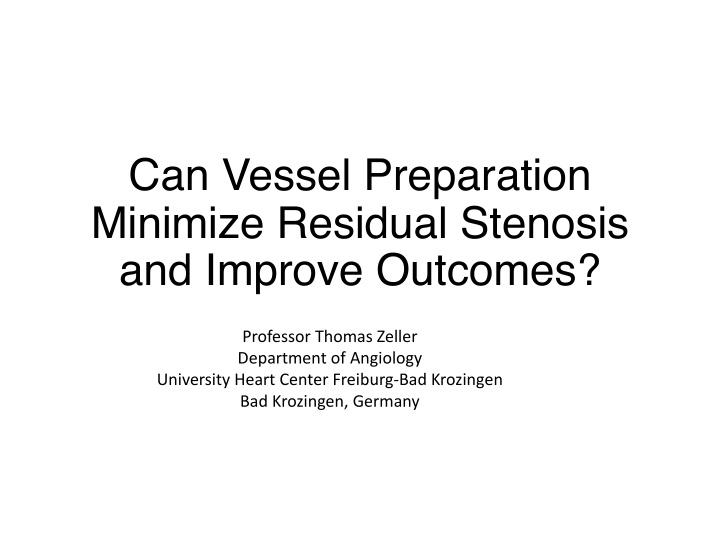



Can Vessel Preparation Minimize Residual Stenosis and Improve Outcomes? Professor Thomas Zeller Department of Angiology University Heart Center Freiburg-Bad Krozingen Bad Krozingen, Germany
Purpose of Vessel Preparation Creates an optimal environment for angioplasty:
FLEX Vessel Preparation System Sheath Size 6 French Wire Compatibility .014 and .018 Catheter Length 40cm and 120cm 0.01 ” in Height 3 Atherotomes (Proximal) CE Mark / FDA Indication for Use: To facilitate dilation of stenoses in the femoral and popliteal arteries and treatment of obstructive lesions of native or synthetic arteriovenous dialysis fistulae
The FLEX System • 3 Proximal Atherotomes Mounted on Skids • Controlled Depth Micro-Incision OCT Image of Micro-Incision • Retrograde Pull-Back • Rotation Control (1:1 torque) • A One Size Fits All Device . Histology of Micro-Incision (Cadaveric Human SFA)
Mechanism of Action • Precise longitudinal micro-incisions • Skid surface area prevents perforation • Atherotomes interact with vessel surface at 1 atm • Creates a controlled environment for angioplasty • Basket “flexes” to plaque contour.
Parallel FLEX Micro-Incisions Human cadaver SFA, SEM Image magnified 150x
Acute Real-World Data • 457 Patients treated • 66 Institutions, 100 Physicians Definitions : Procedural Success: Residual Stenosis ≤ 30% Opening Balloon Pressure: Lowest pressure required to fully efface the lesion. • Average Age: 71 years old • Average Lesion Length: 13.7 cm • Chronic Total Occlusions: 44% • Average Baseline Stenosis: 92%
Vessel Preparation by the FLEX • Angiogram is Captured Prior to Angioplasty Evaluating Luminal Gain and Safety of the FLEX. Post FLEX Alone: Average Luminal Gain: 29.5% Pre-Procedure Post FLEX
Procedural Results • DCB utilized in 73% of cases • Average Opening Balloon Pressure: 4.5 atm Grade A Dissections 4.6% Grade B Dissections 1.3% Flow-Limiting Dissection 0% Perforation 0% Embolization 0% • No Bail-Out Stenting Required • Provisional Stent Use: 21.7% • Average Residual Stenosis: 10% • Procedural Success: 97.2% Post FLEX & DCB
Stent Cohort Percentage of CTOs • No Flow-Limiting Dissections 60 60 • All Provisional 50 44 40 • Increased Average Lesion Length (cm) 30 20 10 • Higher percentage of CTOs 0 Stent Cohort All Cases 16.6 Stent Cohort 13.7 All Cases 0 2 4 6 8 10 12 14 16 18 • No Change to FLEX Luminal Gain or Residual Stenosis 100 90 95 92 80 70 60 50 40 30 29.5 29.5 20 10 10 10 0 Baseline Stenosis Post FLEX Lumen Gain Residual Stenosis All Cases Stent Cohort
Conclusion • Vessel preparation with the FLEX System achieved a high rate of procedural success. ¾ cases used DCB post FLEX. • Low opening balloon pressures suggest improvement in vessel wall compliance with use of the FLEX. Low dissection rate with no flow-limiting dissections. • All stenting was provisional; longer lesions and CTOs tended towards stenting. • Further studies are warranted on the long-term benefits.
Recommend
More recommend